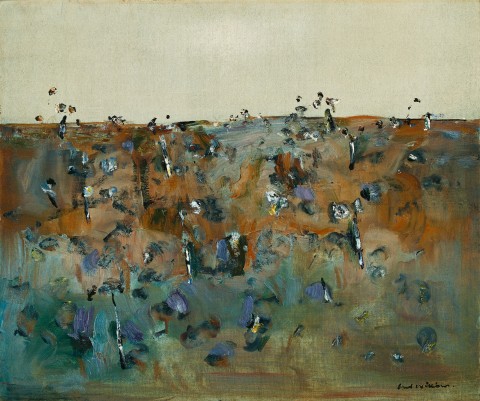LYSTERFIELD, 1965
FRED WILLIAMS
oil on canvas
71.0 x 85.0 cm
signed lower right: Fred Williams
bears artist’s label verso with artist name, title, medium and dimensions
Private collection, Melbourne
Avant Galleries, Melbourne
Private collection, Melbourne, acquired from the above in 1970s
We are grateful to Lyn Williams for her assistance with this catalogue entry.
The immediate response in seeing Lysterfield 1965 is the connection we make with other major works by Williams from the same period. In the mid-late sixties his reputation as Australia’s most original landscape painter was taking hold - he was still in his late thirties. The welcome surprise is that this work has come to light for the first time in decades.
Lysterfield, Upwey and Sherwood are close to each other and now about a 40 minute drive east of Melbourne. Williams and his wife, Lyn, moved to Upwey in 1962. Its topography provided the wellspring for many great works with their subtly shifting style. From compressed compositions where vertical delineations splice through an overall landscape effect, to the raised horizon line with calligraphic marks below it suggest the randomness of the landscape. And the sparse and minimal paintings where all traditional compositional elements have gone and glazed surfaces are filled will painterly gestures echoing the landscape.
Williams’ respect for a particular location as a recurring source of inspiration was not new. He admired the Barbizon School and Camille Corot in particular, where painting en plein air and studio work held equal value.1 Lysterfield is a studio work but we can see its formative ideas talking shape in contemporaneous watercolours and drawings.2 Like most works Lysterfield is given a descriptive title, no romantic flourishes to suggest anything beyond the observed source which inspired the painting. This is one marker of his greatness – to refer to a specific place but to speak of the Australian landscape more broadly - to create a painting which, within itself, carries a robust intention well beyond any topographical identifiers.
In 1963 he was awarded the Helena Rubenstein Scholarship and travelled to Europe. Before he returned from London in 1964 he bought rolls of canvas and had them shipped to Australia and soon ceased painting on board. Lysterfield has technical characteristics which reveal Williams’ keen art historical eye. In Venice he carefully noted the glazes of the Venetian Masters. Colour is pushed into the weave of the canvas as painterly layers rise to a crescendo of immediate impasto gestures, and the incremental application of wet on wet (and drying) paint achieves his unique pictorial synchronicity.
When we take into account Williams’ technique and pictorial interests two other major works, amongst many, come to mind: Upwey 1965, National Gallery of Victoria and Upwey Landscape 1964 – 65, Tate, London.3 Works with single delineated elements such as a high horizon line occur frequently from this period. ‘Skies are an infinite space and the landscape below is vast and contained within the artist’s imagination and his deft, painterly control. The surface becomes an expanse for Williams’ distinctive minimal forms and flecked intonations, where the immediacy of painting never allows for any gesture to be repeated. All the while they suggest the unpatterned irregularity of something observed and formed into an astonishing work of art in the studio’.4
1.The Barbizon School was an informal collective of like-minded artists who worked around the small village of Barbizon south of Paris, the nearby Forest of Fontainebleau was a favourite subject. All believed in taking the landscape as a primary expression where mythical figures, allegory and narrative held no interests. Many of its main exponents such as Corot, Theodore Rousseau and Charles-Francois Daubigny are represented in the National Gallery of Victoria.
2. Lyn Williams confirms Lysterfield is a studio work
3. Upwey Landscape, 1965, oil on canvas, National Gallery of Victoria, Felton Bequest 1965.
Upwey Landscape, 1964-65, oil on hardboard, Tate, London, purchased 1995.
4. Essay for lot 18, Upwey, 1965 oil on canvas. Deutscher + Hackett, Twenty Classics of Australian Art, Melbourne, 11 November 2020.
DOUG HALL, AM
